
In Christian art, a Madonna is a religious depiction of the Blessed Virgin Mary in a singular form or sometimes accompanied by the Child Jesus. These images are central icons for both the Roman Catholic and Orthodox churches. The word is from Italian ma donna 'my lady' (archaic). The Madonna and Child type is very prevalent in Christian iconography, divided into many traditional subtypes especially in Eastern Orthodox iconography, often known after the location of a notable icon of the type, such as the Theotokos of Vladimir, Agiosoritissa, Blachernitissa, etc., or descriptive of the depicted posture, as in Hodegetria, Eleusa, etc.

Pietro Lorenzetti or Pietro Laurati was an Italian painter, active between c. 1306 and 1345. Together with his younger brother Ambrogio, he introduced naturalism into Sienese art. In their artistry and experiments with three-dimensional and spatial arrangements, the brothers foreshadowed the art of the Renaissance.

Pinturicchio, or Pintoricchio, also known as Benetto di Biagio or Sordicchio, was an Italian Renaissance painter. He acquired his nickname because of his small stature and he used it to sign some of his artworks that were created during the fifteenth and sixteenth centuries.

Taddeo di Bartolo, also known as Taddeo Bartoli, was an Italian painter of the Sienese School during the early Renaissance. His biography appears in the Vite of Giorgio Vasari, who claims that Taddeo was the uncle of Domenico di Bartolo.

Neri di Bicci (1419–1491) was an Italian painter active in his native Florence. A prolific painter of mainly religious themes, he studied under his father, Bicci di Lorenzo, who had in turn studied under his father, Lorenzo di Bicci. The three thus formed a lineage of great painters that began with Neri's grandfather.

Jacobello del Fiore was a Venetian painter in the late fourteenth century and early fifteenth century. His early work is in the Late Gothic style popularized by Altichiero da Verona and Jacopo Avanzi, two of his contemporaries, while his mature work displays a local Venetian style established by the school of Paolo Veneziano, an artist and workshop proprietor with notable Byzantine inspiration in his work. This stylistic return to his roots sets him apart from Niccolò di Pietro and Zanino di Pietro, Venetian contemporaries he is often associated with. During his lifetime, he received commissions primarily on the Adriatic coast and in Venice.

Lippo Memmi was an Italian painter from Siena. He was the foremost follower of Simone Martini, who was his brother-in-law.

The San Zeno Altarpiece is a polyptych altarpiece by the Italian Renaissance painter Andrea Mantegna created around 1456–1459. It remains in situ in the Basilica di San Zeno, the main church of the Northern Italian city of Verona. Mantegna's style mixes Greco-Roman classical themes along with Christian subjects in this altarpiece. The central panel, along with the three paintings that comprise the predella, were taken in 1797 by the French. While the main, central scene was returned by the French to Verona in 1815, the three predella paintings in Verona today are copies, since the original ones remain in France at the Louvre (Crucifixion) and in the Musée des Beaux-Arts in Tours. The paintings are made with tempera on panel; not oil as mistakenly identified in one source.

Lorenzo di Bicci was an Italian painter of the Florentine School considered to be one of the most important painters in Florence during the second half of the 14th century. He is believed to have learned his trade from his father, about whom little is known. Lorenzo’s style, as well as that of his contemporaries Jacopo di Cione and Niccolò di Pietro Gerini, was influenced by the artist Andrea di Cione. Lorenzo's paintings made use of bright colors and his compositions avoided complexity. The figures he painted tended to have round faces and were often expressionless. Another one of Lorenzo's distinctive characteristics was his precision of execution. He was known for exceptional talent in drawing, an ability that he put to use at the initial stages of his painting. Unlike many celebrated Florentine artists of this period, Lorenzo mostly received commissions from the country clergy and from the lower-middle-class Florentine guilds. His successors, Bicci di Lorenzo and Neri di Bicci, continued to serve these groups.
Andrea Vanni was an Italian painter of the early Renaissance, active mainly in his native Siena.
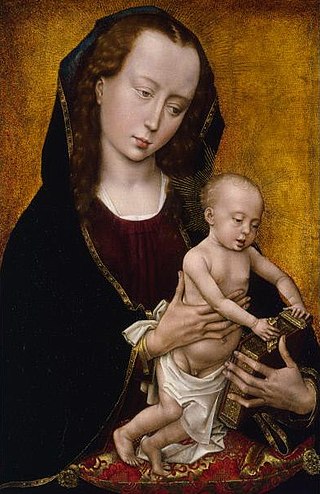
The Diptych of Philip de Croÿ with The Virgin and Child consists of a pair of small oil-on-oak panels painted c. 1460 by the Netherlandish artist Rogier van der Weyden. While the authorship and dating of both works are not in doubt, it is believed but not proven that they were created as wings of a devotional diptych and that at some unknown time the panels were broken apart. A diptych panel fitting the description of the Mary wing was described in a 1629 inventory of paintings owned by Alexandre d'Arenberg, a descendant of Philip I de Croÿ (1435–1511). Both have been approximately dated to 1460 and are now in Antwerp and San Marino, CA respectively. The reverse of de Croÿ's portrait is inscribed with the family crest and the title used by the sitter from 1454 to 1461.
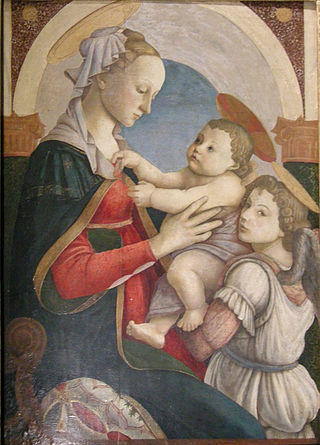
The Madonna and Child with an Angel is a painting executed c. 1465–1467 by the Italian Renaissance painter Sandro Botticelli. It is housed in Spedale degli Innocenti of Florence.

A Madonna of humility or Virgin of humility is a depiction in art of the Virgin Mary sitting on the ground, or upon a low cushion. She usually holds the Christ Child in her lap, making it one form of the Madonna and Child. The iconography originated in the 14th century, and was most common in that and the following century.
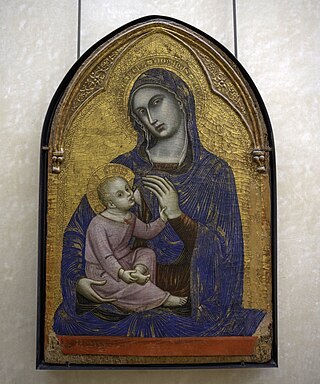
The Nursing Madonna, Virgo Lactans, or Madonna Lactans, is an iconography of the Madonna and Child in which the Virgin Mary is shown breastfeeding the infant Jesus. In Italian it is called the Madonna del Latte. It was a common type in painting until the change in atmosphere after the Council of Trent, in which it was rather discouraged by the church, at least in public contexts, on grounds of propriety.

The Annunciation is a painting by Fra Filippo Lippi hung in the Martelli Chapel in the left transept of the Basilica di San Lorenzo, Florence, Italy. There are several paintings by Lippi of this same name.

The San Zaccaria Altarpiece is a painting by the Italian Renaissance painter Giovanni Bellini, executed in 1505 and located in the church of San Zaccaria, Venice.

The San Giobbe Altarpiece is a c. 1487 altarpiece in oils on panel by the Venetian Renaissance painter Giovanni Bellini. Inspired by a plague outbreak in 1485, this sacra conversazione painting is unique in that it was designed in situ with the surrounding architecture of the church, and was one of the largest sacra conversazione paintings at the time. Although it was originally located in the Church of San Giobbe, Venice, it is now in the Gallerie dell'Accademia in Venice after having been stolen by Napoleon Bonaparte.
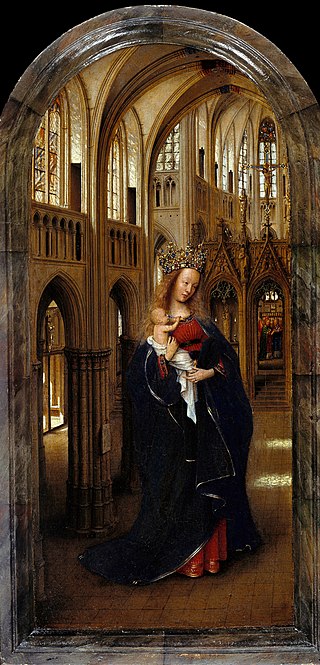
Madonna in the Church is a small oil panel by the early Netherlandish painter Jan van Eyck. Probably executed between c. 1438–1440, it depicts the Virgin Mary holding the Child Jesus in a Gothic cathedral. Mary is presented as Queen of Heaven wearing a jewel-studded crown, cradling a playful child Christ who gazes at her and grips the neckline of her red dress in a manner that recalls the 13th-century Byzantine tradition of the Eleusa icon. Tracery in the arch at the rear of the nave contains wooden carvings depicting episodes from Mary's life, while a faux bois sculpture in a niche shows her holding the child in a similar pose. Erwin Panofsky sees the painting composed as if the main figures in the panel are intended to be the sculptures come to life. In a doorway to the right, two angels sing psalms from a hymn book. Like other Byzantine depictions of the Madonna, van Eyck depicts a monumental Mary, unrealistically large compared to her surroundings. The panel contains closely observed beams of light flooding through the cathedral's windows. It illuminates the interior before culminating in two pools on the floor. The light has symbolic significance, alluding simultaneously to Mary's virginal purity and God's ethereal presence.
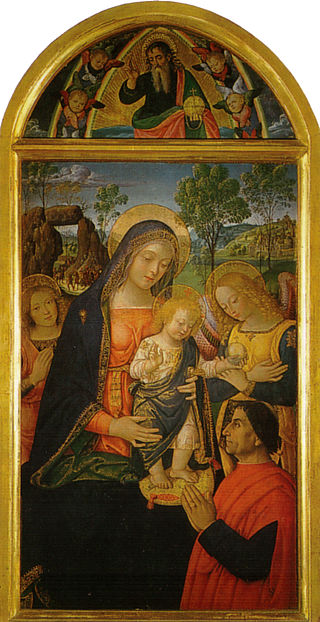
Madonna of Peace is an oil on panel painting by Pinturicchio, now in the Pinacoteca Civica Padre Pietro Tacchi Venturi in San Severino Marche. It is one of the few authentically autographed works from the artist's early mature period.

Madonna and Child with Saints and Donor is a c. 1490 oil on panel painting by Carlo Crivelli. It shows the Madonna and child between Francis of Assisi and Bernardino of Siena, with a tiny figure of the painting's donor kneeling on the balustrade in front of the Madonna. It is stored at the Walters Art Museum in Baltimore.



















